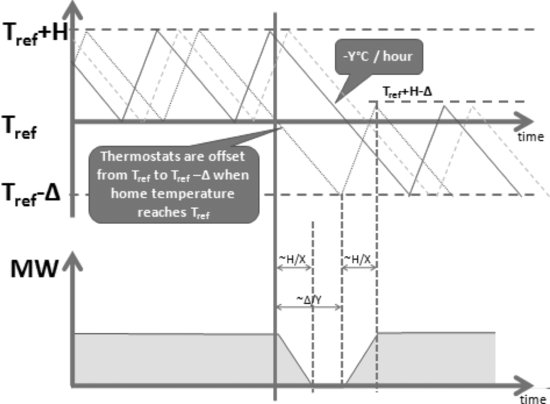Appendix C
Changing Tref without Introducing Correlation
It is possible to decrease Tref without creating a synchronizing event: for instance at t = 0 we can start to change Tref to Tref − Δ in each home, but only when the home temperature reaches Tref (Figure C.1).
With this new strategy, the effect on power demand is progressive: for each unit of time the heating system in k homes reaching temperature Tref remains off: aggregate energy demand decreases from k.H/X to zero in H/X hours. After Δ/Y h, the first homes reach Tref −Δ, the thermostat turns the heating system back on, and aggregate energy demand increases again, before stabilizing to the same level as before we decreased the thermostat temperature.
C.1 Effect of an Increase of Tref
Homes participating in a demand-response program accept only temporary changes to their home's temperature. At some point therefore the thermostat temperature must be increased again from Tref −Δ to Tref.
In order to avoid creating any synchronizing event, a possible strategy is to change the thermostat temperature for all homes that reach Tref + H−Δ (Figure C.2).
If Δ/X < H/Y (case of (Figure C.1), the number of active heating systems increases from k.H/X to k.(H + Δ)/X in Δ/X hours: energy demand increases to P(H + Δ)/H, then remains constant, above average, for H/Y−Δ/X hours, then returns to its average value in Δ/X hours.
Figure C.1 Decreasing Tref without creating a synchronizing event.

Figure C.2 Adjusting the thermostat back to its normal settings.

If Δ/X > H/Y, the number of active heating systems increases from k.H/X to k.(H/X + H/Y) in H/Y hours: energy demand increases to Pmax, then remains constant at the maximum possible value Pmax, for Δ/X−H/Y hours, then returns to its average value in H/Y hours.
